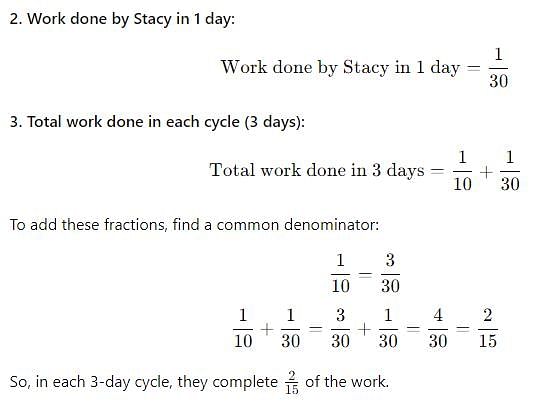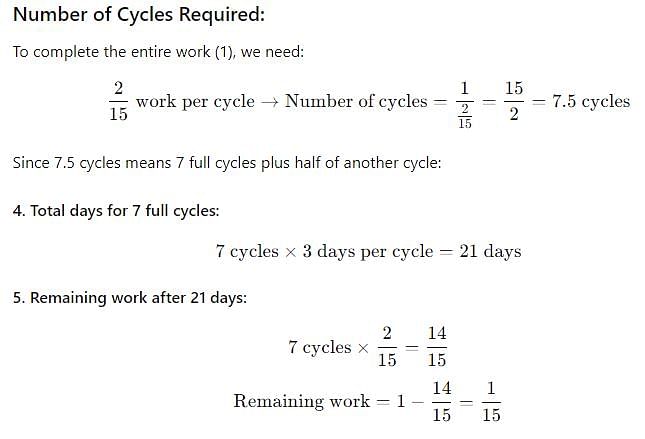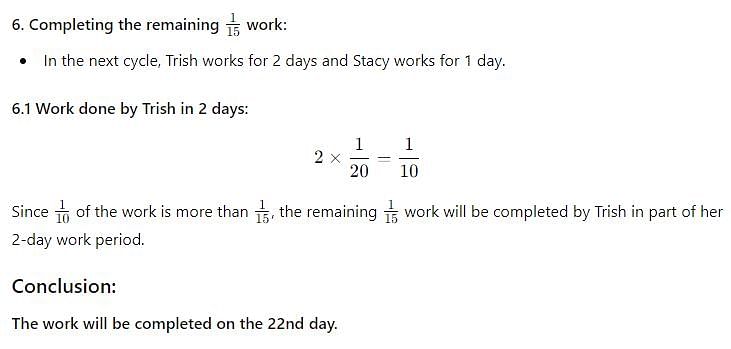SSC Exam > SSC Questions > Trish and Stacy can complete a work in 20 day...
Start Learning for Free
Trish and Stacy can complete a work in 20 days and 30 days, respectively, when working alone. In an arrangement, Trish works for 2 days, and then Stacy works for a day. They keep on repeating this process till the work gets completed. On which day will the work gets completed?
- a)21st
- b)23nd
- c)22rd
- d)24th
Correct answer is option 'C'. Can you explain this answer?
Verified Answer
Trish and Stacy can complete a work in 20 days and 30 days, respective...




 This question is part of UPSC exam. View all SSC courses
This question is part of UPSC exam. View all SSC courses
Most Upvoted Answer
Trish and Stacy can complete a work in 20 days and 30 days, respective...
Calculation:
Trish's work rate = 1/20 per day
Stacy's work rate = 1/30 per day
Working together:
Combined work rate = 1/20 + 1/30 = 1/12 per day
Explanation:
- In 3 days, Trish completes 3/20 of the work.
- In the next day, Stacy completes 1/30 of the work.
- So, in 4 days, they complete (3/20 + 1/30) = 1/12 of the work.
This means they complete 1/12 of the work every 4 days.
Work Completion:
- On the 4th day, they complete 1/12 of the work.
- On the 8th day, they complete 2/12 of the work.
- On the 12th day, they complete 3/12 of the work.
- On the 16th day, they complete 4/12 of the work.
- On the 20th day, they complete 5/12 of the work.
- On the 24th day, they complete 6/12 = 1/2 (or 50%) of the work.
- Therefore, the work gets completed on the 24th day.
Therefore, the correct answer is option 'd) 24th'.
Trish's work rate = 1/20 per day
Stacy's work rate = 1/30 per day
Working together:
Combined work rate = 1/20 + 1/30 = 1/12 per day
Explanation:
- In 3 days, Trish completes 3/20 of the work.
- In the next day, Stacy completes 1/30 of the work.
- So, in 4 days, they complete (3/20 + 1/30) = 1/12 of the work.
This means they complete 1/12 of the work every 4 days.
Work Completion:
- On the 4th day, they complete 1/12 of the work.
- On the 8th day, they complete 2/12 of the work.
- On the 12th day, they complete 3/12 of the work.
- On the 16th day, they complete 4/12 of the work.
- On the 20th day, they complete 5/12 of the work.
- On the 24th day, they complete 6/12 = 1/2 (or 50%) of the work.
- Therefore, the work gets completed on the 24th day.
Therefore, the correct answer is option 'd) 24th'.

|
Explore Courses for SSC exam
|

|
Similar SSC Doubts
Trish and Stacy can complete a work in 20 days and 30 days, respectively, when working alone. In an arrangement, Trish works for 2 days, and then Stacy works for a day. They keep on repeating this process till the work gets completed. On which day will the work gets completed?a)21stb)23ndc)22rdd)24thCorrect answer is option 'C'. Can you explain this answer?
Question Description
Trish and Stacy can complete a work in 20 days and 30 days, respectively, when working alone. In an arrangement, Trish works for 2 days, and then Stacy works for a day. They keep on repeating this process till the work gets completed. On which day will the work gets completed?a)21stb)23ndc)22rdd)24thCorrect answer is option 'C'. Can you explain this answer? for SSC 2024 is part of SSC preparation. The Question and answers have been prepared according to the SSC exam syllabus. Information about Trish and Stacy can complete a work in 20 days and 30 days, respectively, when working alone. In an arrangement, Trish works for 2 days, and then Stacy works for a day. They keep on repeating this process till the work gets completed. On which day will the work gets completed?a)21stb)23ndc)22rdd)24thCorrect answer is option 'C'. Can you explain this answer? covers all topics & solutions for SSC 2024 Exam. Find important definitions, questions, meanings, examples, exercises and tests below for Trish and Stacy can complete a work in 20 days and 30 days, respectively, when working alone. In an arrangement, Trish works for 2 days, and then Stacy works for a day. They keep on repeating this process till the work gets completed. On which day will the work gets completed?a)21stb)23ndc)22rdd)24thCorrect answer is option 'C'. Can you explain this answer?.
Trish and Stacy can complete a work in 20 days and 30 days, respectively, when working alone. In an arrangement, Trish works for 2 days, and then Stacy works for a day. They keep on repeating this process till the work gets completed. On which day will the work gets completed?a)21stb)23ndc)22rdd)24thCorrect answer is option 'C'. Can you explain this answer? for SSC 2024 is part of SSC preparation. The Question and answers have been prepared according to the SSC exam syllabus. Information about Trish and Stacy can complete a work in 20 days and 30 days, respectively, when working alone. In an arrangement, Trish works for 2 days, and then Stacy works for a day. They keep on repeating this process till the work gets completed. On which day will the work gets completed?a)21stb)23ndc)22rdd)24thCorrect answer is option 'C'. Can you explain this answer? covers all topics & solutions for SSC 2024 Exam. Find important definitions, questions, meanings, examples, exercises and tests below for Trish and Stacy can complete a work in 20 days and 30 days, respectively, when working alone. In an arrangement, Trish works for 2 days, and then Stacy works for a day. They keep on repeating this process till the work gets completed. On which day will the work gets completed?a)21stb)23ndc)22rdd)24thCorrect answer is option 'C'. Can you explain this answer?.
Solutions for Trish and Stacy can complete a work in 20 days and 30 days, respectively, when working alone. In an arrangement, Trish works for 2 days, and then Stacy works for a day. They keep on repeating this process till the work gets completed. On which day will the work gets completed?a)21stb)23ndc)22rdd)24thCorrect answer is option 'C'. Can you explain this answer? in English & in Hindi are available as part of our courses for SSC.
Download more important topics, notes, lectures and mock test series for SSC Exam by signing up for free.
Here you can find the meaning of Trish and Stacy can complete a work in 20 days and 30 days, respectively, when working alone. In an arrangement, Trish works for 2 days, and then Stacy works for a day. They keep on repeating this process till the work gets completed. On which day will the work gets completed?a)21stb)23ndc)22rdd)24thCorrect answer is option 'C'. Can you explain this answer? defined & explained in the simplest way possible. Besides giving the explanation of
Trish and Stacy can complete a work in 20 days and 30 days, respectively, when working alone. In an arrangement, Trish works for 2 days, and then Stacy works for a day. They keep on repeating this process till the work gets completed. On which day will the work gets completed?a)21stb)23ndc)22rdd)24thCorrect answer is option 'C'. Can you explain this answer?, a detailed solution for Trish and Stacy can complete a work in 20 days and 30 days, respectively, when working alone. In an arrangement, Trish works for 2 days, and then Stacy works for a day. They keep on repeating this process till the work gets completed. On which day will the work gets completed?a)21stb)23ndc)22rdd)24thCorrect answer is option 'C'. Can you explain this answer? has been provided alongside types of Trish and Stacy can complete a work in 20 days and 30 days, respectively, when working alone. In an arrangement, Trish works for 2 days, and then Stacy works for a day. They keep on repeating this process till the work gets completed. On which day will the work gets completed?a)21stb)23ndc)22rdd)24thCorrect answer is option 'C'. Can you explain this answer? theory, EduRev gives you an
ample number of questions to practice Trish and Stacy can complete a work in 20 days and 30 days, respectively, when working alone. In an arrangement, Trish works for 2 days, and then Stacy works for a day. They keep on repeating this process till the work gets completed. On which day will the work gets completed?a)21stb)23ndc)22rdd)24thCorrect answer is option 'C'. Can you explain this answer? tests, examples and also practice SSC tests.

|
Explore Courses for SSC exam
|

|
Signup for Free!
Signup to see your scores go up within 7 days! Learn & Practice with 1000+ FREE Notes, Videos & Tests.



















